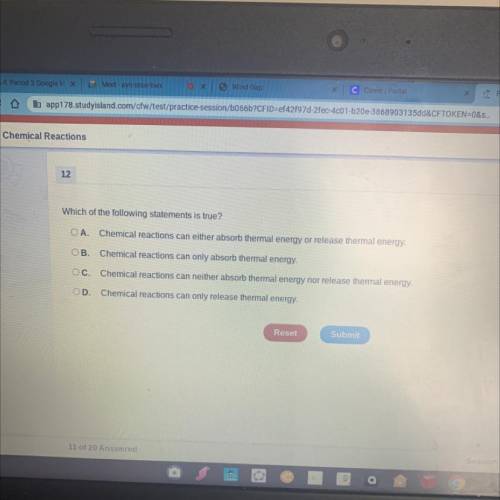
Biology, 02.02.2021 19:10 abtj4r7668g
Which of the following statements is true?
OA. Chemical reactions can either absorb thermal energy or release thermal energy
ОВ.
Chemical reactions can only absorb thermal energy.
OC.
Chemical reactions can neither absorb thermal energy nor release thermal energy.
OD.
Chemical reactions can only release thermal energy.


Answers: 3


Another question on Biology

Biology, 22.06.2019 00:00
Does masterbation affect height growth or loss of growth hormone?
Answers: 2

Biology, 22.06.2019 03:00
Where does all the water go? according to the environmental protection agency (epa), in a typical wetland environment, 39% of the water is outflow; 46% is seepage; 7% evaporates; and 8% remains as water volume in the ecosystem (reference: united states environmental protection agency case studies report 832-r-93-005). chloride compounds as residuals from residential areas are a problem for wetlands. suppose that in a particular wetland environment the following concentrations (mg/l) of chloride compounds were found: outflow, 60.4; seepage, 73.7; remaining due to evaporation, 26.4; in the water volume, 46.8. (a) compute the weighted average of chlorine compound concentration (mg/l) for this ecological system. (round your answer to one decimal place.) mg/l (b) suppose the epa has established an average chlorine compound concentration target of no more than 58 mg/l. does this wetlands system meet the target standard for chlorine compound concentration? yes. the average chlorine compound concentration (mg/l) is too high. yes. the average chlorine compound concentration (mg/l) is lower than the target. no. the average chlorine compound concentration (mg/l) is lower than the target. no. the average chlorine compound concentration (mg/l) is too high.
Answers: 3

Biology, 22.06.2019 07:00
Environmental science are unconsidered with methods to preserve natural resourcesa.trueb.false
Answers: 1

Biology, 22.06.2019 07:30
1. seamount a raised footwall block between normal fault creates this 2. syncline break between rocks where a hanging wall rises relative to a footwall 3. hot spring on rolling hills, this a dip between hills 4. volcanic neck created when a block with hanging walls slips down between normal faults 5. caldera underwater volcano that never reaches above sea level 6. horst natural hot water on earth's surface containing many minerals 7. graben underwater volcano whose top is eroded flat by waves 8. crater less than a mile in diameter; looks like a bowl at the top of a volcano 9. guyot magma that filled the central vent that remains after the volcano has eroded 10. reverse fault over 1 mile in diameter; looks like a bowl over a volcano
Answers: 3
You know the right answer?
Which of the following statements is true?
OA. Chemical reactions can either absorb thermal energy...
Questions





Computers and Technology, 02.03.2021 20:20


Computers and Technology, 02.03.2021 20:20

Mathematics, 02.03.2021 20:20

Mathematics, 02.03.2021 20:20



Biology, 02.03.2021 20:20

English, 02.03.2021 20:20

Biology, 02.03.2021 20:20

Mathematics, 02.03.2021 20:20


Mathematics, 02.03.2021 20:20

Advanced Placement (AP), 02.03.2021 20:20

Mathematics, 02.03.2021 20:20

Physics, 02.03.2021 20:20



